 I’m really on the fence about getting a mammogram this year.
I’m really on the fence about getting a mammogram this year.
I’ve done so much research for this blog and the more I read, the more I question whether it’s really an advantage to me.
8 years ago when I first found the lump that later tests would reveal was breast cancer, I’d had a mammogram a scant 5 months prior and it didn’t show a thing. How did it get from not showing up on a mammogram screening to a 2.5 cm lump in 5 months? Why didn’t the mammogram pick it up? Or did it really just “blow up” during those intervening (and stressful) months?
I really believe we need a test that detects the early signs of malignancy, ie what makes the cancer grow and become lethal. THAT’S what we really need.
Mammography leaves a lot to be desired, I think, especially when you consider the dose of radiation you get when having one. Plus there’s the problem of false positive tests needlessly traumatizing millions of women who are sent for unnecessary biopsies and other follow-up testing.
Fran Visco of the National Breast Cancer Coalition doesn’t think that pink ribbons and mammograms are the answer to ending breast cancer and I agree. She recently stated, “Mammography, or any imaging modality, will never be the answer to breast cancer. It has inherent limitations that cannot be overcome. It simply finds some cancers that already exist.” Which of course, we do want – early detection seems to be an important factor in surviving this disease. But they don’t necessarily save you.
The problem is that research shows that while the number of mammograms has dramatically increased in America, death rates have not dramatically decreased. The percentage of women aged 40 and older who reported having a mammogram rose from 29% in 1987 to 65% in 2008, according to the National Health Interview Survey. The mortality rate from breast cancer has decreased by an average of 2.2% per year from 1990 to 2008, according to the National Cancer Institute. That’s just not good enough!
There’s a very interesting article over at the New York Times entitled “Mammogram’s Role as Savior Is Tested“. Check it out.
For myself, I much prefer thermal imaging (see my article “Breast Screening Without the Squish” on the subject).
I don’t have health insurance though, and even if I did, it wouldn’t be covered. I believe thermal imaging is a much better diagnostic tool, but it’s not cheap, costing around $300. The reason I like it is that it is much safer (no radiation) and it can indicate where a problem area could be occurring long before a tumor develops due to the heat signature of developing blood vessels (called angiogenesis).
Still haven’t decided what to do. Your comments are invited.
If you’d like to stay connected, sign up for my free e-newsletters on the right, and/or “like” me on Facebook (Marnie Clark, Breast Health Coach) and I’ll do my utmost to keep you informed and empowered on your healing journey.



i haven’t had breast cancer but I’ve been through it with far too many friends– found out about yours after the fact. I love what you’re doing—and I too, have wondered about the effectiveness of mammograms vs. thermal imaging or other diagnostics. I’m also wondering– you know how they do bloodwork and look for “markers”? Is there any sort of pre-test out there?
Dear Karin, here’s an article that may answer your question: http://www.breastcancer.org/symptoms/testing/types/blood_marker.jsp . The way I understand it, though, with breast cancer if the blood “markers” are present, the disease is already spreading and could be on its way to metastasizing already, so it’s not a good pre-test. The best method that I’m aware of is thermal imaging because it picks up the heat signature that is characteristic of a developing tumor – in order to establish itself the tumor sends out lots of vascular tentacles (angiogenesis) and thermal imaging can pick that up.
In my mother’s case, her doctor followed her blood markers after she had a lumpectomy and radiation and they could see the markers were rising but scans weren’t picking up where it was located. It wasn’t until she broke a bone that they realized the cancer had moved to her bones and by that time it was well established in her body. So for my mother, the blood marker test really didn’t help anything other than increase her anxiety levels.
I recently struggled with a similar issue of ‘how to screen’. As a young woman who has had cancer, do I really want to have that accumulation of radiation across all those extra years a mammogram would be required. Currently I’m hoping for alternatives. Every day I check the news for cancer developments – sooner or later, they HAVE to come up with better screening methods.
Catherine,
I totally agree. Have you tried thermal imaging? Is it available where you are (I assume that’s Canada)?
I realize this is an old post. I have nothing to add here, except my own experience. A mammogram caught a suspicious tiny calcification cluster in my right breast this year. It ended up being stage 1 IDC. So for me, a mammogram was potentially life saving, and part of my general annual wellness plan (thermography is not).
Kendra,
Thanks for your comment. Indeed, many a woman’s life has been saved by mammography. I am just a proponent of using methods of detection that don’t include squashing the breast and irradiating them, both harmful things to do to delicate breast tissue. Better detection methods are on their way (and I wish they’d hurry up!)
Warmest wishes,
Marnie